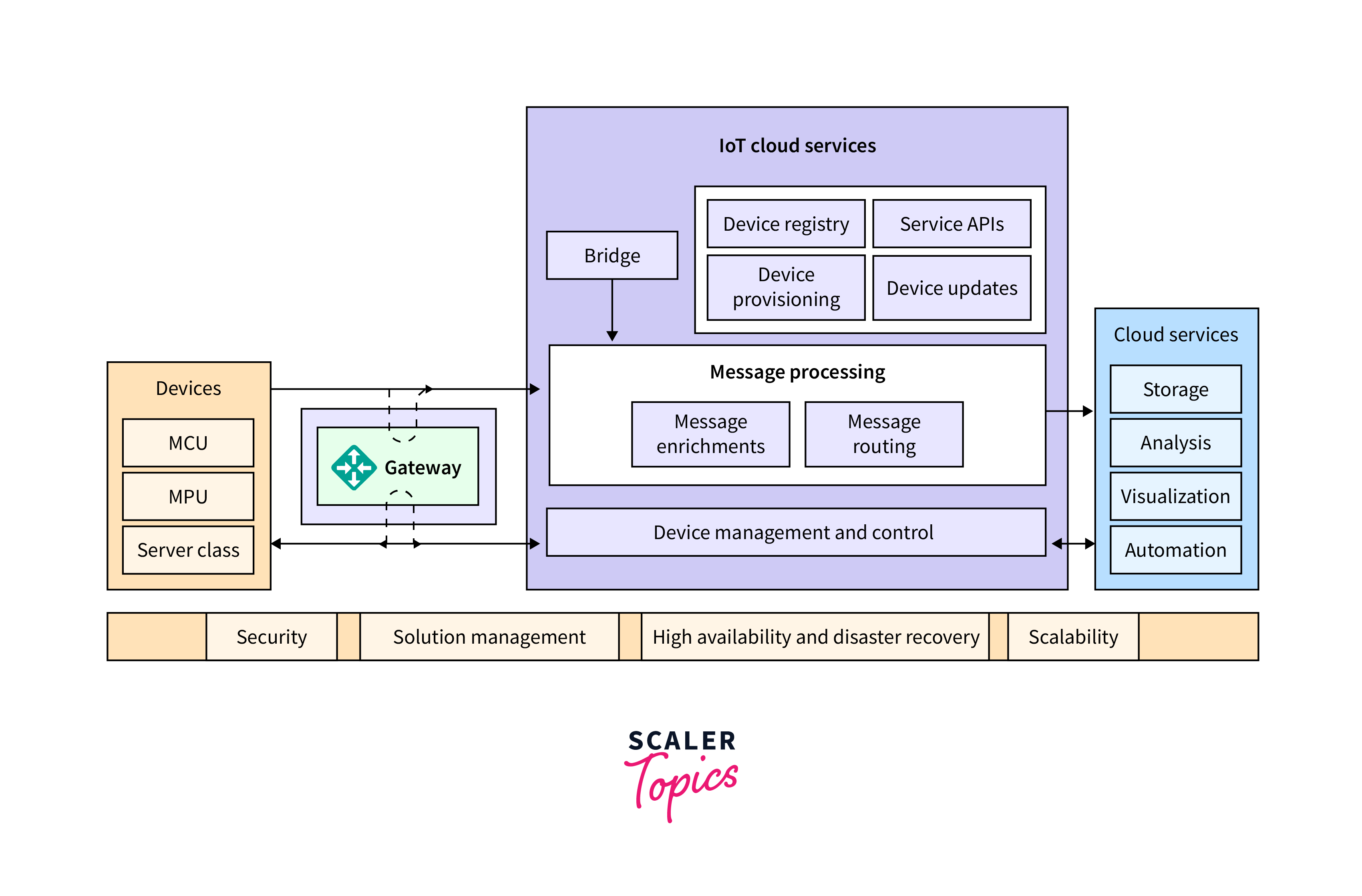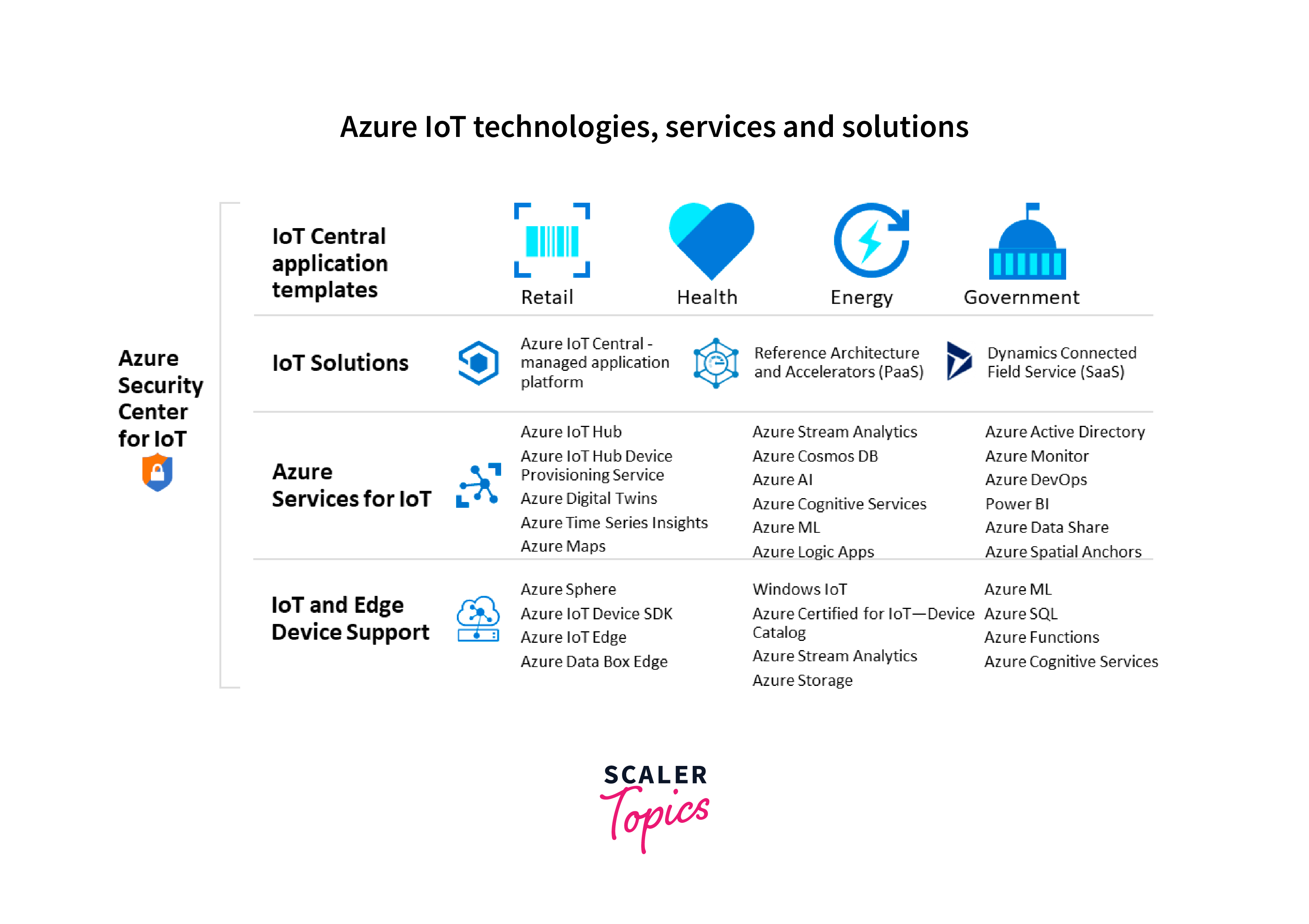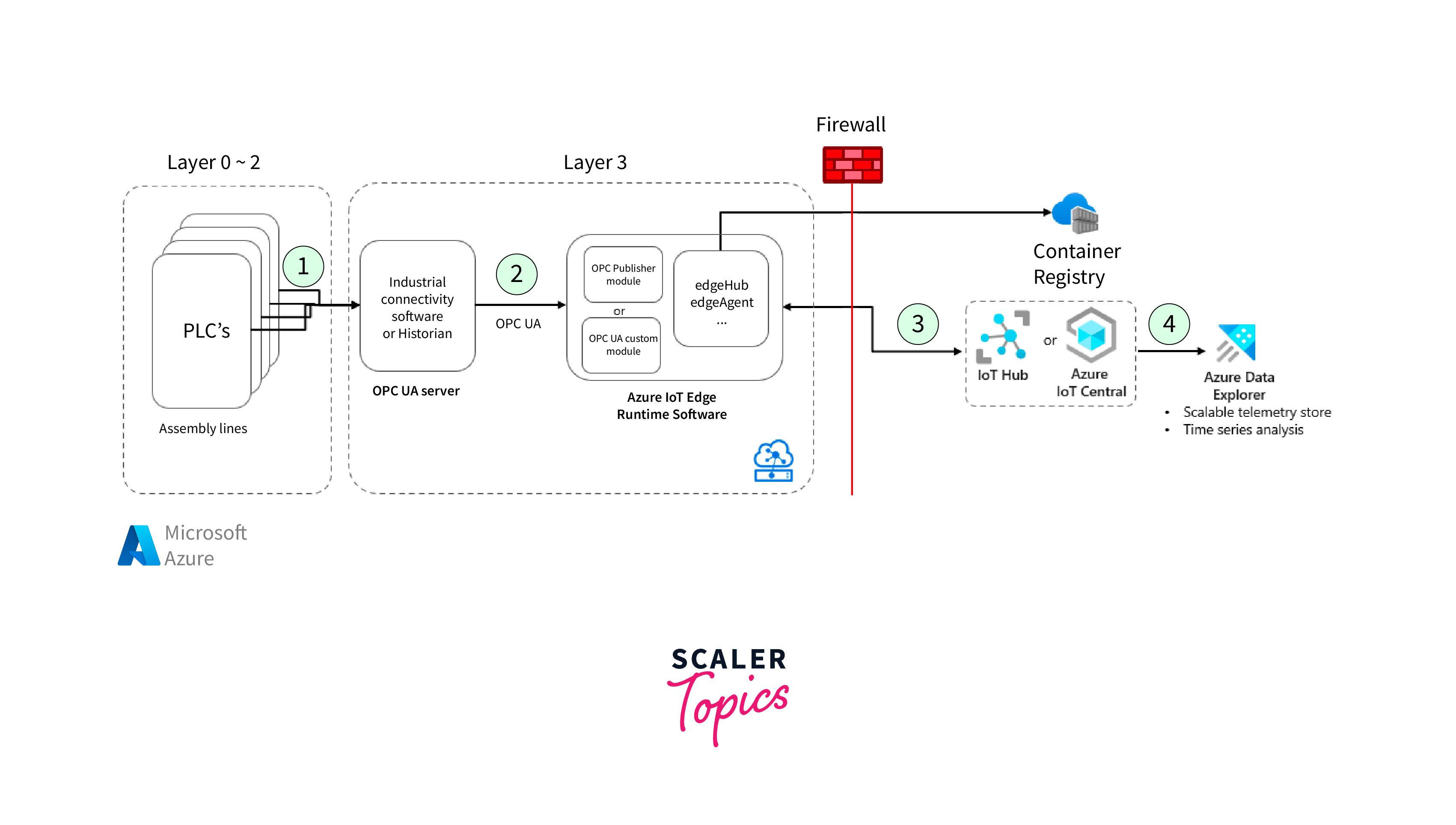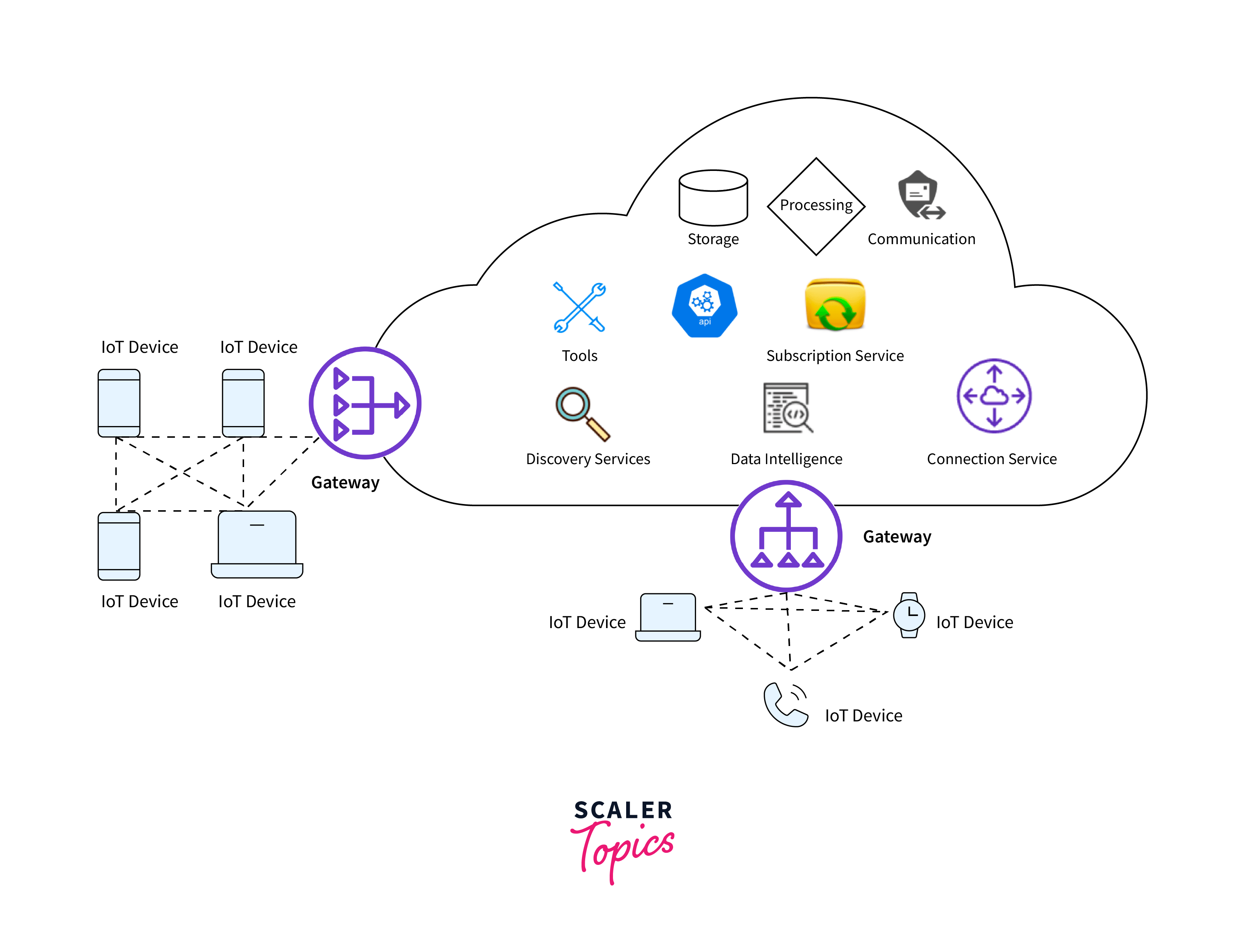Iot in Azure
Overview
Azure IoT (Internet of Things) provides a comprehensive platform for connecting, monitoring, and managing IoT devices. With Azure IoT, users can securely collect, analyze, and act on data generated by a wide range of devices, from sensors to industrial equipment. It offers services like Azure IoT Hub for device management, Azure IoT Central for simplified IoT solution development, and Azure IoT Edge for processing data closer to the source. Azure's robust suite of tools enables organizations to build scalable and secure IoT solutions, integrating seamlessly with other Azure services for advanced analytics, machine learning, and visualization of IoT-generated insights.
What is IOT?
The Internet of Things (IoT) refers to the network of interconnected physical devices embedded with sensors, actuators, software, and connectivity, allowing them to collect and exchange data. This network enables these devices to communicate and interact with each other, as well as with centralized systems, often through the Internet.
Key Characteristics:
-
Connectivity: IoT devices are equipped with communication capabilities, enabling them to connect to the internet, other devices, and centralized systems.
-
Sensing and Actuating: IoT devices have sensors to collect data from their environment and actuators to perform actions based on that data.
-
Data Processing: Collected data is often processed locally on the device or transmitted to centralized systems for analysis and decision-making.
-
Interoperability: IoT promotes interoperability between different devices and systems, allowing seamless communication and collaboration.
-
Connectivity: The foundation of IoT lies in the connectivity of devices, fostering seamless communication and data exchange. Devices are interconnected through various networks, such as Wi-Fi, cellular, or LPWAN (Low Power Wide Area Network).
-
Sensors and Actuators: IoT devices are equipped with sensors to capture real-world data. These sensors can detect environmental changes, monitor conditions, and gather information. Actuators, on the other hand, enable devices to perform physical actions or respond to commands based on the data collected.
-
Data Collection: One of the primary functions of IoT is the continuous collection of data from the physical environment. This data can include temperature, humidity, location, and various other parameters depending on the type of device.
-
Data Processing: The collected data undergoes processing, either locally on the device or in the cloud. Data processing involves analyzing the information to derive meaningful insights, identify patterns, and make informed decisions.
What is Azure IOT?
Azure IoT (Internet of Things) is a comprehensive set of cloud services provided by Microsoft Azure to facilitate the development, deployment, and management of IoT solutions. It offers a scalable and secure platform for connecting, monitoring, and controlling IoT devices, as well as processing and analyzing the data generated by these devices.
Key components of Azure IoT include:
-
Azure IoT Hub: Azure IoT Hub is a pivotal component in the Azure ecosystem, designed to streamline the management and communication of Internet of Things (IoT) devices.
-
Azure IoT Central: An IoT application platform that simplifies the development of scalable and customizable IoT solutions without the need for extensive coding or infrastructure management.
-
Azure IoT Edge: Extends Azure IoT capabilities to the edge, allowing devices to run AI, analytics, and other workloads locally to reduce latency and enhance efficiency.
-
Azure IoT Solution Accelerators: Pre-built solutions for common IoT scenarios, providing a quick start for development in areas such as remote monitoring, predictive maintenance, and device provisioning.
-
Azure Time Series Insights: Enables the storage, analysis, and visualization of time-series data generated by IoT devices, supporting powerful insights and decision-making.

Benefits of Azure for IoT
Azure offers a robust and integrated set of services that bring several benefits to IoT (Internet of Things) applications. Here are the key advantages of using Azure for IoT:
-
Scalability: Azure provides a scalable platform that can effortlessly handle the growing number of connected devices, ensuring optimal performance as IoT solutions expand.
-
Security: Azure offers robust security features, including device authentication, encryption, and access control, ensuring the protection of IoT data and infrastructure against potential threats.
-
Device Management: Azure IoT Hub allows for efficient device provisioning, configuration, and monitoring, simplifying the management of large fleets of IoT devices.
-
Connectivity: Azure IoT Hub provides reliable and bi-directional communication between devices and the cloud, ensuring seamless data transfer and control.
-
Edge Computing: Azure IoT Edge enables the processing of data at the edge, reducing latency and optimizing bandwidth by running analytics and AI locally on devices.

Performance Considerations for Azure IoT:
-
Message Size and Format:
- Optimize message size and format to reduce data transfer overhead.
- Consider using efficient serialization formats like JSON or Protocol Buffers.
-
Device Twin and Direct Methods Usage:
- Efficiently use Device Twins for device configuration.
- Minimize the use of direct methods to conserve bandwidth.
-
Batching and Aggregation:
- Aggregate multiple messages into batches to reduce the number of individual transactions.
- Leverage batching capabilities offered by IoT Hub or Event Hubs.
-
QoS Levels:
- Choose the appropriate Quality of Service (QoS) level for messaging, considering the trade-off between reliability and performance.
-
Device-to-Cloud and Cloud-to-Device Communication:
- Optimize communication patterns based on the specific needs of your IoT application.
- Use efficient protocols such as MQTT or AMQP for communication.

Cost Considerations for Azure IoT:
-
Message Volume:
- Costs are often tied to the number of messages transmitted.
- Consider message compression and aggregation to optimize costs.
-
Storage Usage:
- Costs may be associated with storing telemetry data.
- Implement data retention policies and use cost-effective storage solutions.
-
Device Count:
- Some services may have costs associated with the number of registered devices.
- Plan for device management efficiently to control costs.
-
Message Routing:
- Evaluate the cost implications of message routing rules.
- Optimize routing to reduce unnecessary data transfer costs.
-
IoT Hub Tier:
- Different IoT Hub tiers (Free, Basic, Standard) have varying costs and features.
- Choose a tier based on required features and expected usage.
Connectivity with Azure
Azure offers a range of services and features to facilitate diverse connectivity scenarios:
-
Virtual Networks (VNets): Azure VNets enable the creation of isolated and securely connected network environments within Azure. This allows organizations to define their own IP address space, control traffic flow, and connect resources like virtual machines.
-
Azure ExpressRoute: Provides private, dedicated connections between on-premises data centers and Azure, bypassing the public internet.
-
Azure VPN Gateway: Facilitates the creation of secure Site-to-Site and Point-to-Site VPN connections.
-
Azure IoT Hub: Enables bidirectional communication between IoT applications and devices, ensuring seamless connectivity for managing and monitoring IoT devices at scale.
-
Azure API Management: Allows organizations to create, publish, and manage APIs, enabling seamless connectivity between applications and services.
-
Azure Event Grid: Provides event-driven, serverless computing, and supports a publish-subscribe model.
-
Azure Logic Apps: Allows the creation of workflows that integrate with various Azure services, SaaS applications, and on-premises systems.
-
Azure Service Bus: A messaging service that enables reliable and asynchronous communication between applications and services.

How are Cloud Services Used in IOT Use Cases?
Here's how cloud services are commonly used in IoT scenarios:
-
Data Ingestion and Storage:
- Use Case: IoT devices continuously generate data.
- Cloud Service: Cloud storage services like Azure Blob Storage or Amazon S3 are used to ingest, store, and manage large volumes of data from IoT devices.
-
Data Processing and Analytics:
- Use Case: Analyzing and extracting insights from IoT data.
- Cloud Service: Services like Azure Stream Analytics or AWS IoT Analytics enable real-time or batch processing of IoT data, allowing for analytics, pattern recognition, and trend analysis.
-
Device Management:
- Use Case: Managing and monitoring IoT devices at scale.
- Cloud Service: Azure IoT Hub or AWS IoT Core provides device management capabilities, allowing organizations to securely connect, monitor, and manage IoT devices.
-
Edge Computing:
- Use Case: Processing data closer to the source for reduced latency.
- Cloud Service: Azure IoT Edge and AWS IoT Greengrass both extend cloud capabilities to edge devices, empowering them to perform local data processing and analytics.
-
Scalable and Resilient Architecture:
- Use Case: Ensuring the reliability and scalability of IoT solutions.
- Cloud Service: Cloud providers offer scalable infrastructure, such as Azure IoT Hub's scalable messaging infrastructure or AWS IoT's highly available and scalable MQTT broker.

Azure IOT Services
Azure offers a comprehensive set of IoT (Internet of Things) services that enable the development, deployment, and management of IoT solutions. Here are key Azure IoT services:
-
Azure IoT Hub:
- Purpose: Device management and bi-directional communication.
- Features: Securely connect, monitor, and manage IoT devices at scale. Supports messaging patterns, device twins, and direct methods.
-
Azure IoT Central:
- Purpose: Rapid development of IoT solutions without extensive coding.
- Features: Provides an application platform with built-in IoT features, including device connectivity, monitoring, and analytics.
-
Azure IoT Edge:
- Purpose: Extends cloud intelligence to edge devices.
- Features: Allows running Azure services, custom logic, and machine learning models on edge devices. Enhances performance and reduces latency.
-
Azure Stream Analytics:
- Purpose: Real-time analytics and processing of streaming data.
- Features: Ingests, processes, and analyzes real-time data streams. Integrates with Azure IoT Hub for seamless IoT data processing.
-
Azure Time Series Insights:
- Purpose: Storage, analysis, and visualization of time-series data.
- Features: Enables users to explore and analyze time-series data, helping with trend analysis and operational insights.
-
Azure Maps:
- Purpose: Geospatial and location-based services for IoT solutions.
- Features: Provides APIs for mapping, geocoding, and route optimization. Integrates location data with IoT applications.
Azure IOT Hub
Azure IoT Hub is a cloud service provided by Microsoft Azure that enables secure and scalable communication between IoT (Internet of Things) applications and the devices it manages. Here are key features and aspects of Azure IoT Hub:
-
Device Connectivity:
- Azure IoT Hub supports various communication protocols, including MQTT, AMQP, and HTTP, providing flexibility for connecting a diverse range of IoT devices.
-
Device Management:
- It offers robust device management capabilities, allowing organizations to provision, register, and manage large fleets of IoT devices at scale.
-
Security and Authentication:
- Azure IoT Hub ensures secure communication with devices through features such as per-device authentication, SSL/TLS encryption, and integration with Azure Active Directory.
-
Device Twins:
- Device Twins are JSON documents that store device metadata and state information. They enable synchronization of device status between the cloud and the device, facilitating efficient management.
-
Message Routing:
- Azure IoT Hub allows the definition of routing rules based on message content, enabling automatic distribution of messages to designated endpoints or services within Azure.
-
Scalability:
- It provides a scalable infrastructure to handle a large number of devices and high message throughput, accommodating the growth of IoT deployments.
-
Monitoring and Diagnostics:
- Azure IoT Hub integrates with Azure Monitor, providing telemetry and diagnostic information to monitor the health and performance of IoT solutions.
-
Integration with Other Azure Services:
- Azure IoT Hub seamlessly integrates with other Azure services, such as Azure Stream Analytics, Azure Functions, and Azure Logic Apps, enabling advanced analytics, processing, and automation.
-
Device-to-Cloud and Cloud-to-Device Messaging:
- Facilitates both device-to-cloud and cloud-to-device messaging, allowing devices to send data to the cloud and receive commands or updates from the cloud.
Conclusion
- Azure IoT Hub provides a scalable and reliable platform for connecting a diverse range of IoT devices, accommodating the growth of IoT deployments.
- Robust device management capabilities enable organizations to efficiently provision, register, and manage large fleets of IoT devices at scale.
- Azure IoT Hub prioritizes security with features such as per-device authentication, SSL/TLS encryption, and integration with Azure Active Directory, ensuring secure communication.
- The use of device twins facilitates synchronization of device metadata and state information between the cloud and devices, enhancing management efficiency.
- Azure IoT Hub allows the definition of routing rules based on message content, enabling automatic distribution of messages to designated endpoints or services within Azure.
